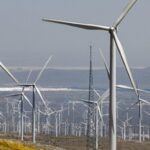Posts tagged with 'World Resources Institute'
The past year registered record-shattering global temperatures. People around the world are already witnessing epic heat waves, wildfires and drought at 1.1 degrees C (2 degrees F) of global warming, compared to pre-industrial averages. With current policies putting the world on ...

The Guacheneque Páramo, where the Bogotá River originates, represents the second largest source of drinking water for the city of Bogotá, Colombia. It is a key ecosystem that supplies water to approximately 25% of the city’s 7 million inhabitants. However, due to ...

If you’re a regular reader of TheCityFix, you’re no stranger to the vital role that cities play in shaping the future of our planet. From leading the shift to zero-emission transportation networks to advancing solutions to curb plastic waste at ...

The minibus taxi (MBT) industry is the backbone of South Africa’s public transportation system with a fleet of approximately 250,000 vehicles, operated by thousands of providers, employing some 600,000 drivers. MBTs account for 80% of all journeys taken by taxi ...

Today’s city leaders face a level of complexity and rapid pace of change that can be overwhelming. Particularly in developing countries, urbanization is unfolding quickly and often haphazardly. One in three urban residents worldwide lack adequate access to at least ...

Over the past 10 years, large energy buyers including corporations and cities have taken major strides to reduce energy-related greenhouse gas emissions by setting 100% renewable energy targets and then purchasing renewable electricity to demonstrate progress on an annual basis. ...

Indore is known as India’s cleanest city, having secured the title seven years in a row in Swachh Bharat National Cleanliness Surveys, and it is now determined to clean its air too. On February 15, the “Clean Air, Clean Indore” ...

South Africa’s cities are economic engines, drawing workers across the country and the continent. Of the country’s 58.8 million population, 68% live in urban areas. Between 2000 and 2014, urban area in South Africa expanded by 1,464 km2. Population projections ...

A key objective of the Clean Air Catalyst is to exchange knowledge, build trust and foster opportunities to elevate the voices of those most impacted by air pollution, particularly women and low-income communities. Funded by the U.S. Agency for International ...

China’s transport CO2 emissions accounted for 11% of the world’s transport greenhouse gas (GHG) emissions, following only the United States (21%), according to data from Climate Watch. And these numbers have been growing rapidly: The average annual growth rate of China’s transport ...

After two years of unprecedented disruption to transport globally and two years of virtual conferences, Transforming Transportation returned to Washington, DC, March 14-15. More than 900 policymakers, experts and leaders in transport gathered at the World Bank Headquarters to explore ...

Transportation is a crucial enabler of economic development, providing people access to markets, employment, education, and health services. In addition to these development benefits, improving transport systems by making them cleaner, safer, more inclusive and more resilient accelerates climate action ...

More than 20 million students in the United States ride school buses every year. This equals approximately 7 billion trips per year, making school buses one of the most widely used forms of public transport in the United States. But those trips aren’t always ...

Visit transformingtransportation.org to watch full sessions from the conference. And join the conversation on Twitter with #TTDC22. After COP26, transport has reached an important milestone in the global climate conversation. The electric revolution is underway and it’s now a centerpiece ...

Visit transformingtransportation.org to watch full sessions from the conference. And join the conversation on Twitter with #TTDC22. The case for decarbonizing transport cannot be clearer: it’s the fastest growing sector of emissions after industry, representing nearly a quarter of CO2 ...


























